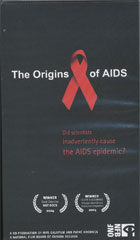
The Origins of AIDS: Did Scientists Inadvertently Cause the AIDS Epidemic? 2003
Distributed by National Film Board of Canada, 1123 Broadway, Suite 307, New York, NY 10010; 800-542-2164
Produced by Galafilm Productions Inc., Multimedia France Productions, Pathe Archives, Les Films de la Passerelle, RTBF, and Produce+
Directed by Peter Chappell and Catherine Peix
VHS, color, 43 min.
Jr. High - Adult
Bioethics, Biology, Ethics, Health Sciences, History, Science
Date Entered: 02/28/2006
Reviewed by Emily Hart, Daniel A. Reed Library, State University of New York College at FredoniaThrough the investigation of how AIDS began, this highly persuasive film encourages viewers to take a hard look at the often unsafe practices used by the scientific community when creating vaccines. The film explores two theories for the emergence of AIDS. The first is the Hunter Theory, in which humans are believed to have contracted the Simian Immunodeficiency Virus (SIV), a virus that is closely related to HIV, through the hunting and handling of chimpanzees. The second is the theory made visible by Edward Hooper, author of the book, The River, which attempts to link the spread of AIDS to the distribution of the CHAT oral polio vaccine.
In the race to create an oral polio vaccine, scientist Hilary Koprowski manufactured and distributed the CHAT vaccine in the late 1950’s, in the Belgian Congo (now the Democratic Republic of Congo). Edward Hooper charges that Koprowski’s vaccine initiated the AIDS pandemic. Hooper’s evidence suggests that this vaccine was created using live tissue cultures, generated from chimpanzee cells, which possibly carried the SIV virus. Millions of Africans were injected with the vaccine and possibly the virus. In the years following the distribution of the vaccine, the Belgian Congo and surrounding areas produced some of the first known cases of AIDS.
Hooper’s theory was debated by the Royal Society in London, causing a great stir among the scientific community. Despite the fact that no definitive evidence was found to back Hooper’s theory, the investigation helped draw attention to the ethics of the scientific community and the safety precautions they fail to take.
This film uses a series of images, live footage, and interviews to investigate Hooper’s theory. Although backed with factual evidence, the film is persuasive and sympathetic to Hooper. Despite this fact, the film succeeds in educating viewers on the varying theories about the history of a deadly disease, while forcing them to question the scientific practices which have become widely accepted by society.
Awards
- Best Director, Hot Docs, 2004
- Silver Hugo Award, Chicago International Television Competition, 2004